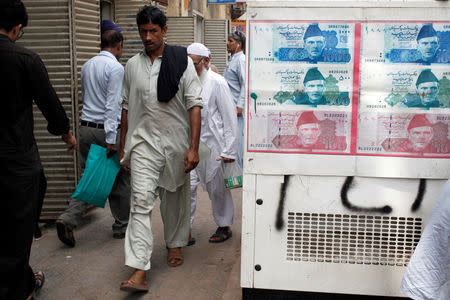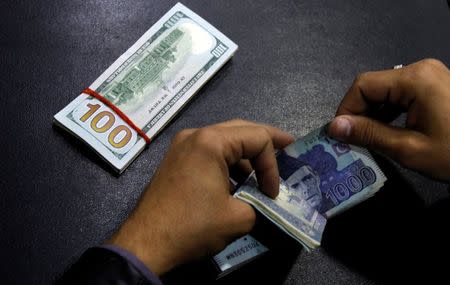Pakistan's new rupee devaluation shows economic risk before election
By Syed Raza Hassan and Asif Shahzad
KARACHI/ISLAMABAD (Reuters) - The Pakistani rupee slumped 3.8 percent against the dollar on Monday before slightly recovering in what appeared to be the third currency devaluation in seven months by the central bank amid fears of a balance of payments crisis.
The rupee's decline to 119.85 per U.S. dollar threatens to squeeze consumers just days before the Eid holiday, which ends the Islamic fasting month of Ramadan, and ahead of a general election set for July 25.
The apparent devaluation shows signs of vulnerability in Pakistan's nearly $300 billion economy, as dwindling foreign reserves and a widening current account deficit trigger speculation about going back to the International Monetary Fund for loans for the second time since 2013.
The State Bank of Pakistan said on Monday the rupee's fall was a "market-based adjustment", adding it was monitoring the situation "and stands ready to ensure stability in the financial markets and curb the emergence of speculative pressures."
Ashfaque Hasan Khan, an economist with the National Institute of Science and Technology, said the interim government that now holds the reins during the election campaign might itself be forced to go to the IMF.
Khan said the interim government needs to take policy decisions to curb imports and increase exports, but so far the caretaker government has not taken enough steps.
"If we rely exclusively on the rupee devaluation to address our balance of payment crises, this will have disastrous consequences," he said.
The outgoing government led by the Pakistan Muslim League-Nawaz has touted its stewardship of the economy as a reason to bring the party back to power, but foreign reserves are now at a low of two months' worth of imports.
The PML-N policy for years was to keep the rupee relatively stable in what was widely considered a managed float, but as the current account deficit widened and foreign reserves dropped to about half their peak, the policy shifted.
Since December, the rupee has fallen by about 14 percent.
The rupee closed at 119.85 per U.S. dollar on Monday after opening at 115.63. Earlier in the day, it traded close to 121 per dollar, traders said.
"On Monday the central bank didn't intervene (to support the rupee) and allowed the market to determine the rupee value," Samiullah Tariq, director of research at Arif Habib Securities, told Reuters
Withdrawal of support would have the effect of devaluing the currency as the SBP is the most influential player in the thinly traded local foreign exchange market and controls what is widely considered a managed float system.
In December and in March, the rupee was devalued, each time by about 5 percent, by the central bank.
Pakistan's economy is expected to expand by close to 6 percent this year, the fastest pace in more than a decade, but a widening of the current account deficit has brought new worries.
The current account deficit now stands at $14 billion, around 5.3 percent of gross domestic product, an SBP official said.
The economic outlook has been hurt by the fast depletion of foreign currency reserves, which now stand at just over $10 billion.
Pakistan is currently in discussions with China for loans to ease pressure on its foreign currency reserves.
Over the weekend, the shortage of foreign currency widened the spread at which the rupee is traded in the open market and the interbank market to 4 rupees.
"Whatever has happened again today is the reflection of growing pressure on the balance of payments side,” Khan told Reuters.
"It also exposes the outgoing government claims that ... they are leaving the economy in good shape. That unfortunately isn't the case."
Pakistan's currency woes came as another South Asian country was hit by concerns about trade deficits and external factors including rising oil prices and the strong U.S. dollar.
The Sri Lankan rupee slipped to a fresh record low of 159.80 per dollar on Monday, dragged down by a lack of support for the local currency form exporters, dealers said.
(Reporting by Syed Raza Hassan; Writing by Kay Johnson. Editing by Nick Macfie and Sam Holmes)


